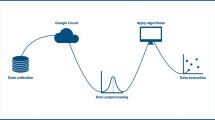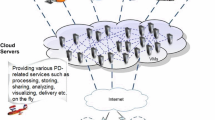Abstract
Now-a-days computational offloading and quick disease prediction are identified as major difficult troubles of smart healthcare systems. As cloud based healthcare is primarily far away from remote patients which leads to high latency, bandwidth and computational usage at some point in real-time monitoring and diagnosis. Due to the expanded demand of real-time healthcare applications, there’s a want for higher quality of experience to carry out the disease prediction undertaking via low latency computational processing. So, the proposed research studies introduces an edge-cloud enabled healthcare system to carry out quick disease prediction in peer-to-peer edge-cloud integrated computing platform by minimizing the latency, bandwidth and computational power metrics. Consequently, a brand new fashion of adaptive cost and energy aware computational offloading scheme and privacy preserving communication protocol using hybrid encryption scheme are introduced. It will perform the real-time secure data offloading and processing among the edge nodes from the region where the affected patient records were initially collected. Also, an Adaptive Fuzzy Optimized k-Nearest Neighbor (AFO-k-NN) classifier model is introduced to predict Parkinson disease and primarily based on severity further diagnosis and rehabilitation process might be achieved by the healthcare system. Experimental evaluation on various offloading procedures and classifier models are made with respect to energy consumption, utility cost, response time, prediction time and prediction accuracy. Our expertise best, the proposed offloading scheme takes very less energy consumption, utility cost and response time while comparing to current cost-based, energy-based and learning-based schemes. In addition, the proposed privacy preserving communication protocol provides more privacy and security during offloading and sharing of patient data. Similarly, the proposed classifier model obtains less prediction time and greater prediction accuracy at the same time as compared to current classifier models.




Similar content being viewed by others
References
Ai Y, Peng M, Zhang K (2018) Edge computing technologies for internet of things: a primer. Digital Communications and Networks 4:77–86. https://doi.org/10.1016/j.dcan.2017.07.001
Geetha R, Suntheya AK, Umarani Srikanth G (2020) Cloud integrated IoT enabled sensor network security: research issues and solutions. Wirel Pers Commun 113:747–771. https://doi.org/10.1007/s11277-020-07251-z
Iman Azimi, Arman Anzanpour, Amir M. Rahmani, Tapio Pahikkala, Marco Levorato, Pasi Liljeberg And Nikil Dutt, "HiCH: hierarchical fog-assisted computing architecture for healthcare IoT", ACM Trans Embed Comput Syst, Vol. 16, No. 5s, 2017, Article 174, pp. 1–22. https://doi.org/10.1145/3126501
Oueida S, Kotb Y, Aloqaily M, Jararweh Y, Baker T (2018) An edge computing based smart healthcare framework for resource management. Sensors 18:4307. https://doi.org/10.3390/s18124307
Tshiamo Sigwele, Yim Fun Hu, Muhammad Ali, Jiachen Hou, Misfa Susanto and Helmy Fitriawan (2018) An intelligent edge computing based semantic gateway for healthcare systems interoperability and collaboration. IEEE 6th International Conference on Future Internet of Things and Cloud (FiCloud), Barcelona, pp. 370–376, https://doi.org/10.1109/FiCloud.2018.00060
Shrivastava R, Pandey M (2020) Real time fall detection in fog computing scenario. Clust Comput 23:2861–2870. https://doi.org/10.1007/s10586-020-03051-z
Thilakanathan D, Chen S, Nepal S, Calvo R, Alem L (2014) A platform for secure monitoring and sharing of generic health data in the Cloud. Futur Gener Comput Syst 35:102–113. https://doi.org/10.1016/j.future.2013.09.011
AamirHussain RW, da Silva AL, Nadher M, Mudhish M (2015) Health and emergency-care platform for the elderly and disabled people in the Smart City. J Syst Softw 110:253–263. https://doi.org/10.1016/j.jss.2015.08.041
Mang S, Zhou B, Fu A, Yu Y, Zhang G (2019) PRTA: a proxy re-encryption based trusted authorization scheme for nodes on CloudIoT. Inf Sci 527:533–547. https://doi.org/10.1016/j.ins.2019.01.051
Luca Cerina, Sara Notargiacomo, Matteo Greco, Marco Domenico Santambrogio (2017) A fog-computing architecture for preventive healthcare and assisted living in smart ambients. IEEE 3rd International Forum on Research and Technologies for Society and Industry, Modena, pp. 1–6. https://doi.org/10.1109/RTSI.2017.8065939
Komnios I, Tsapeli F, Gorinsky S (2015) Cost-effective multi-mode offloading with peer-assisted communications. Ad Hoc Netw 25:370–382. https://doi.org/10.1016/j.adhoc.2014.07.028
Tang W, Zhao X, Rafique W, Qi L, Dou W, Ni Q (2019) An offloading method using decentralized P2P-enabled mobile edge servers in edge computing. J Syst Archit 94:1–13. https://doi.org/10.1016/j.sysarc.2019.02.001
Houssemeddine Mazouzi, Nadjib Achir, Khaled Boussetta, "DM2-ECOP: an efficient computation offloading policy for multi-user multi-cloudlet mobile edge computing environment", ACM Trans Internet Technol, vol. 19, no. 2, Article 24, 2019, pp. 1–24. https://doi.org/10.1145/3241666
Yan H, Zhang X, Chen H, Zhou Y, Bao W, Yang LT (2019) DEED: dynamic energy-efficient data offloading for IoT applications under unstable channel conditions. Futur Gener Comput Syst 96:425–437. https://doi.org/10.1016/j.future.2019.01.014
Rachuri KK, Efstratiou C, Leontiadis I, Mascolo C, Rentfrow PJ (2014) Smartphone sensing offloading for efficiently supporting social sensing applications. Pervasive and Mobile Computing 10:3–21. https://doi.org/10.1016/j.pmcj.2013.10.005
Changsheng You and Kaibin Huang (2018) Energy-efficient peer-to-peer computation offloading based on non-causal CPU-state information. IEEE International Conference on Communications Workshops, Kansas City, MO, USA. https://doi.org/10.1109/ICCW.2018.8403705
Sarathchandr Magurawalage CM, Yang K, Hu L, Zhang J (2014) Energy-efficient and network-aware offloading algorithm for mobile cloud computing. Comput Netw 74:22–23. https://doi.org/10.1016/j.comnet.2014.06.020
Rahman A, Jin J, Rahman A, Cricenti A, Afrin M, Dong Y-n (2019) Energy-efficient optimal task offloading in cloud networked multi-robot systems. Comput Netw 160:11–32. https://doi.org/10.1016/j.comnet.2019.05.016
Yunzheng Tao, Changsheng You, Ping Zhang and Kaibin Huang (2018) Stochastic control of computation offloading to a dynamic helper, IEEE international conference on communications workshops, Kansas City, MO, USA. https://doi.org/10.1109/ICCW.2018.8403703
Chunlin L, Zhu L, Luo Y (2017) Location-aware interest-related micro-cloud topology construction and bacteria foraging-based offloading strategy. Ad Hoc Netw 64:1–21. https://doi.org/10.1016/j.adhoc.2017.06.002
Zhang F, Ge J, Wong C, Li C, Chen X, Zhang S, Luo B, He Z, Chang V (2019) Online learning offloading framework for heterogeneous mobile edge computing system. J Parallel Distributed Comput 128:167–183. https://doi.org/10.1016/j.jpdc.2019.02.003
Ning Z, Dong P, Wang X, Rodrigues JJPC (2019) Deep reinforcement learning for vehicular edge computing: an intelligent offloading system. ACM Trans Intell Syst Technol 10(6):Article 60. https://doi.org/10.1145/3317572
Lin L, Liao X, Jin H, Li P (2019) Computation offloading towards edge computing. Proc IEEE 107(8):1584–1607. https://doi.org/10.1109/JPROC.2019.2922285
Hussain A, Manikanthan SV, Padmapriya T, Nagalingam M (2020) Genetic algorithm based adaptive offloading for improving IoT device communication efficiency. Wirel Netw 26:2329–2338. https://doi.org/10.1007/s11276-019-02121-4
Haridas H, Kailasam S, Dharanipragada J (2019) Cloudy knapsack algorithm for offloading tasks from large scale distributed applications. IEEE Trans Cloud Comput 7(4):949–963. https://doi.org/10.1109/TCC.2017.2713776
Pescosolido L, Conti M, Passarella A (2018) On the impact of the physical layer model on the performance of D2D-offloading in vehicular environments. Ad Hoc Netw 81:197–210. https://doi.org/10.1016/j.adhoc.2018.07.019
Wang C, Li Y, Jin D (2014) Mobility-assisted opportunistic computation offloading. IEEE Commun Lett 18(10):1779–1782. https://doi.org/10.1109/LCOMM.2014.2347272
Zhang J, Zhou Z, Li S, Gan L, Zhang X, Qi L, Xu X, Dou W (2018) Hybrid computation offloading for smart home automation in mobile cloud computing. Pers Ubiquit Comput 22:121–134. https://doi.org/10.1007/s00779-017-1095-0
Flores H, Sharma R, Ferreira D, Kostakos V, Manner J, Tarkoma S, Pan H, Li Y (2017) Social-aware hybrid mobile offloading. Pervasive and Mobile Computing 36:25–43. https://doi.org/10.1016/j.pmcj.2016.09.014
Alabdulatif A, Kumarage H, Khalil I, Yi X (2017) Privacy-preserving anomaly detection in cloud with a lightweight homomorphic approach. J Comput Syst Sci 90:28–45. https://doi.org/10.1016/j.jcss.2017.03.001
Ma M, He D, Fan S, Feng D (2020) Certificateless searchable public key encryption scheme secure against keyword guessing attacks for smart healthcare. 50:Article 102429. https://doi.org/10.1016/j.jisa.2019.102429
Wang Z, Luo N, Pan Z (2020) GuardHealth: Blockchain empowered secure data management and Graph Convolutional Network enabled anomaly detection in smart healthcare. Journal of Parallel and Distributed Computing 142:1–12. https://doi.org/10.1016/j.jpdc.2020.03.004
Alabdulatifa A, Khalilb I, Yi X (2020) Towards secure big data analytic for cloud-enabled applications with fully homomorphic encryption. Journal of Parallel and Distributed Computing 137:192–204. https://doi.org/10.1016/j.jpdc.2019.10.008
Ali Z, Ghani A, Khan I, Chaudhry SA, Hafizul Islam SK, Giri D (2020) A robust authentication and access control protocol for securing wireless healthcare sensor networks. J Inform Secur Appl 52:Article 102502. https://doi.org/10.1016/j.jisa.2020.102502
Chen H-L, Huang C-C, Yu X-G, Xu X, Sun X, Wang G, Wang S-J (2013) An efficient diagnosis system for detection of Parkinson’s disease using fuzzy k-nearest neighbor approach. Expert Syst Appl 40:263–271. https://doi.org/10.1016/j.eswa.2012.07.014
Liu D-Y, Chen H-L, Yang B, Lv X-E, Li L-N, Liu J (2012) Design of an enhanced fuzzy k-nearest neighbor classifier based computer aided diagnostic system for thyroid disease. J Med Syst 36:3243–3254. https://doi.org/10.1007/s10916-011-9815-x
Srinivas K, Raghavendra Rao G, Govardhan A (2014) Rough-fuzzy classifier: a system to predict the heart disease by blending two different set theories. Arab J Sci Eng 39:2857–2868. https://doi.org/10.1007/s13369-013-0934-1
Geng Z, Meng Q, Bai J, Chen J, Han Y, Wei Q, Ouyang Z (2019) A model-free Bayesian classifier. Inf Sci 482:171–188. https://doi.org/10.1016/j.ins.2019.01.026
Mena D, Quevedo JR, Montanes E, del Coz JJ (2017) A heuristic in A* for inference in nonlinear. Probabilistic Classifier Chains 126:78–90. https://doi.org/10.1016/j.knosys.2017.03.015
Akbarnejad A, Baghshah MS (2017) A probabilistic multi-label classifier with missing and noisy labels handling capability. Pattern Recognition Letters 89:18–24. https://doi.org/10.1016/j.patrec.2017.01.022
Luukka P (2009) Similarity classifier using similarities based on modified probabilistic equivalence relations. Knowl-Based Syst 22:57–62. https://doi.org/10.1016/j.knosys.2008.06.005
de la Torre J, Valls A, Puig D (2020) A deep learning interpretable classifier for diabetic retinopathy disease grading. Neurocomputing 396:465–476. https://doi.org/10.1016/j.neucom.2018.07.102
Supriya M, Deepa AJ (2019) A novel approach for breast cancer prediction using optimized ANN classifier based on big data environment. Health Care Management Science 23:414–426. https://doi.org/10.1007/s10729-019-09498-w
Mano LY et al (2016) Exploiting IoT technologies for enhancing health smart homes through patient identification and emotion recognition. Comput Commun 89:178–190. https://doi.org/10.1016/j.comcom.2016.03.010
Sun Y, Wen Q, Zhang Y, Li W (2014, Article ID 214841) Privacy-preserving self-helped medical diagnosis scheme based on secure two-party computation in wireless sensor networks. Computational and Mathematical Methods in Medicine 2014:1–9. https://doi.org/10.1155/2014/214841
Guo W, Shao J, Lu R, Liu Y, Ghorbani AA (2018) A privacy-preserving online medical prediagnosis scheme for cloud environment. 6:48946–48957. https://doi.org/10.1109/ACCESS.2018.2866971
Little MA, McSharry PE, Roberts SJ, Costello DAE, Moroz IM (2007) Exploiting nonlinear recurrence and fractal scaling properties for voice disorder detection. Bio Medical Engineering 6:1–19
Oxford Parkinson's Disease Detection Dataset (2008) Parkinsons Data Set, UCI Machine Learning Repository. http://archive.ics.uci.edu/ml/datasets/parkinsons.
Author information
Authors and Affiliations
Corresponding author
Additional information
Publisher’s note
Springer Nature remains neutral with regard to jurisdictional claims in published maps and institutional affiliations.
Rights and permissions
About this article
Cite this article
Jayaram, R., Prabakaran, S. Adaptive cost and energy aware secure peer-to-peer computational offloading in the edge-cloud enabled healthcare system. Peer-to-Peer Netw. Appl. 14, 2209–2223 (2021). https://doi.org/10.1007/s12083-021-01177-4
Received:
Accepted:
Published:
Issue Date:
DOI: https://doi.org/10.1007/s12083-021-01177-4




